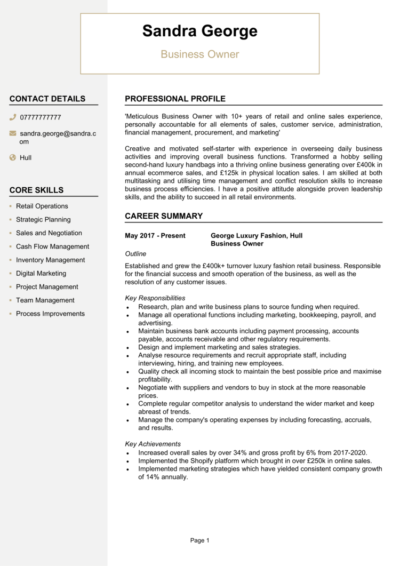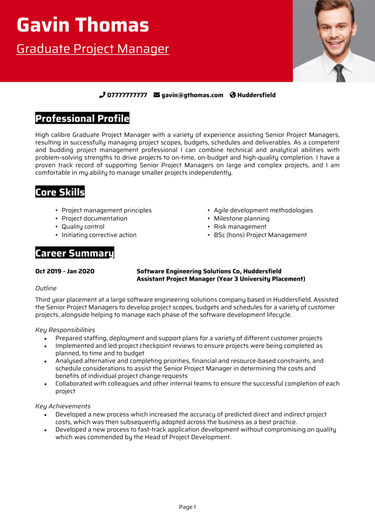Running a business is no small feat – whether you built something from scratch or took the reins of an existing venture, you’ve likely worn more hats than a department store mannequin. But if you’re transitioning into employment or freelance roles, your next move starts with one thing: a well-written CV.
This guide (featuring Business Owner CV examples) will help you translate years of entrepreneurship into a compelling CV that highlights your leadership and commercial expertise to open doors to rewarding new opportunities.
Business Owner CV

Business Manager CV
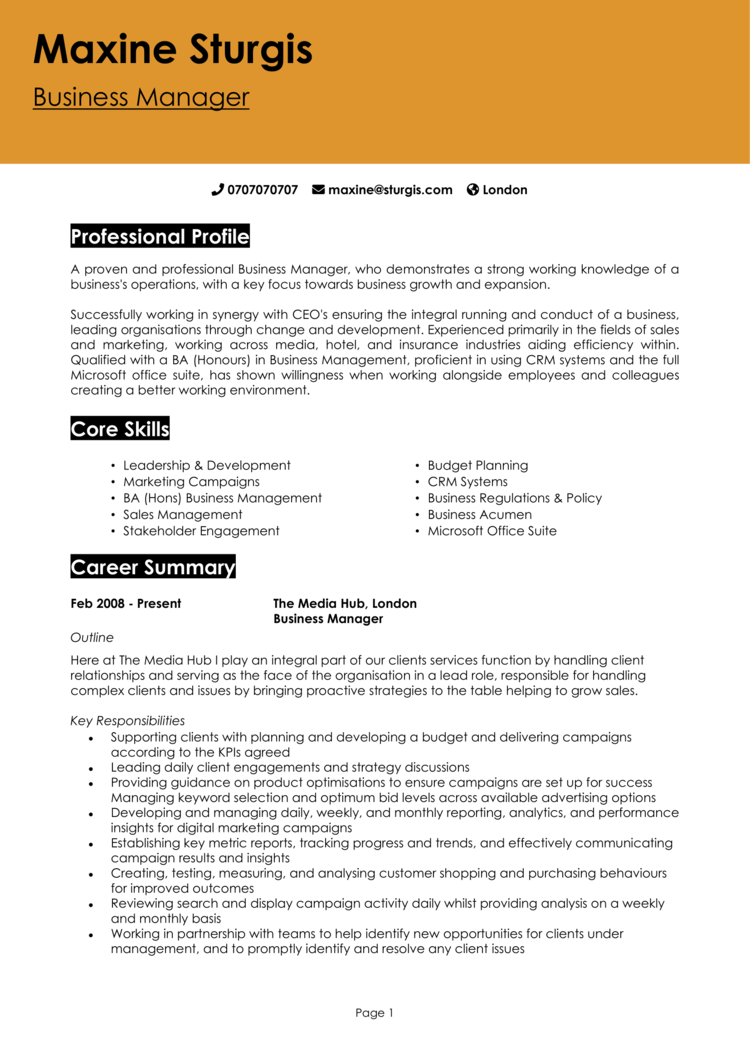
How to write your Business Owner CV
Discover how to craft a winning Business Owner CV that lands interviews with this simple step-by-step guide.
As a business owner, you’ve handled operations, led strategy, juggled clients, and probably did your own accounting along the way. Your CV needs to reflect that wide-ranging experience in a way that makes sense to hiring managers who may not be used to reading entrepreneurial applications.
This guide will show you how to write a CV that turns your self-employed story into a professional narrative – focused on your commercial results and transferable skills that make you a strong hire across industries.
Business Owner CV format and structure guidelines
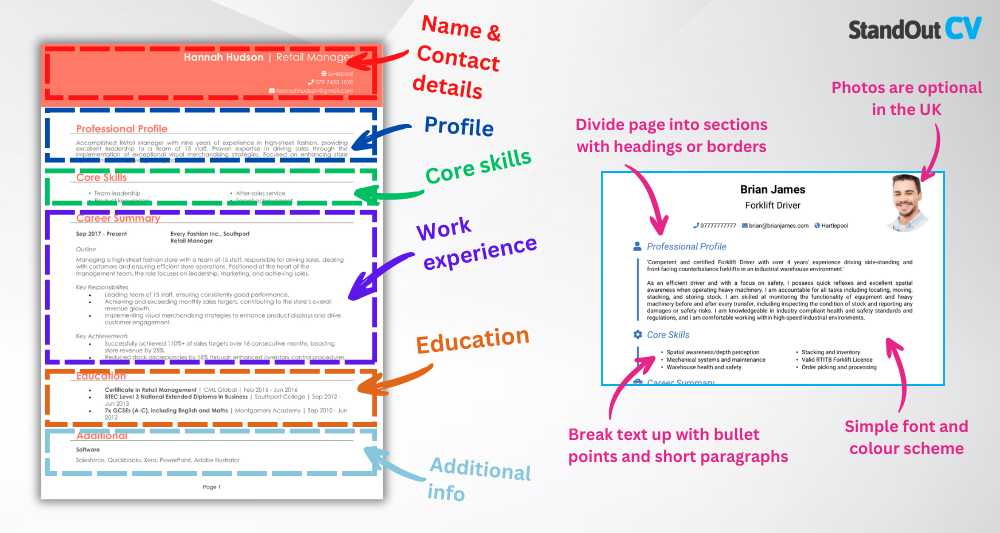
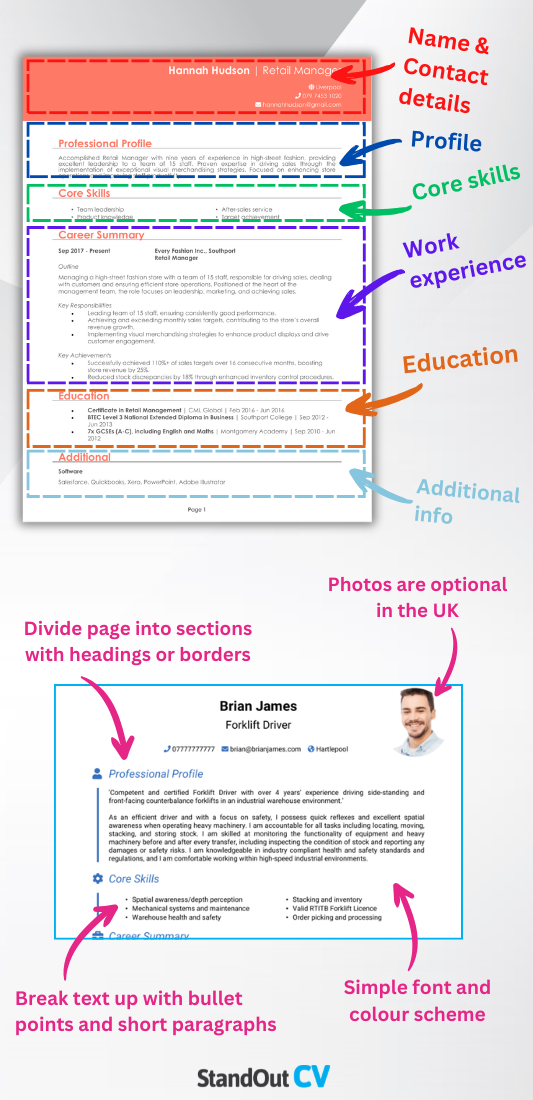
Running a business takes adaptability and clarity – your CV should reflect the same. Employers or clients need to understand your journey at a glance, without struggling to navigate through a less-than-ideal CV structure.
Here’s the layout to follow:
- Name and contact details – Place your name and personal details prominently at the top of your CV for quick access. Adding a photo is up to you.
- Profile – Open with a compelling overview of your skills, experience, and career goals.
- Core skills – Bullet point highlights of your top business, leadership, and industry-relevant skills.
- Work experience – Provide a detailed breakdown of your work history, starting with the most recent job first.
- Education – List formal education, business training, professional development, or any degree.
- Additional info – Optionally include professional memberships, awards, or relevant hobbies.
Keep the document under two pages length. Use bullet points to break down detail, divide each section with clear headings, and choose a tidy, professional font. Consistent formatting not only keeps it readable – it reinforces your ability to present ideas clearly and professionally. Following these helpful tips will ensure your format remains readable, so recruiters stick around to find out what makes you the right fit.
Creating a strong Business Owner profile
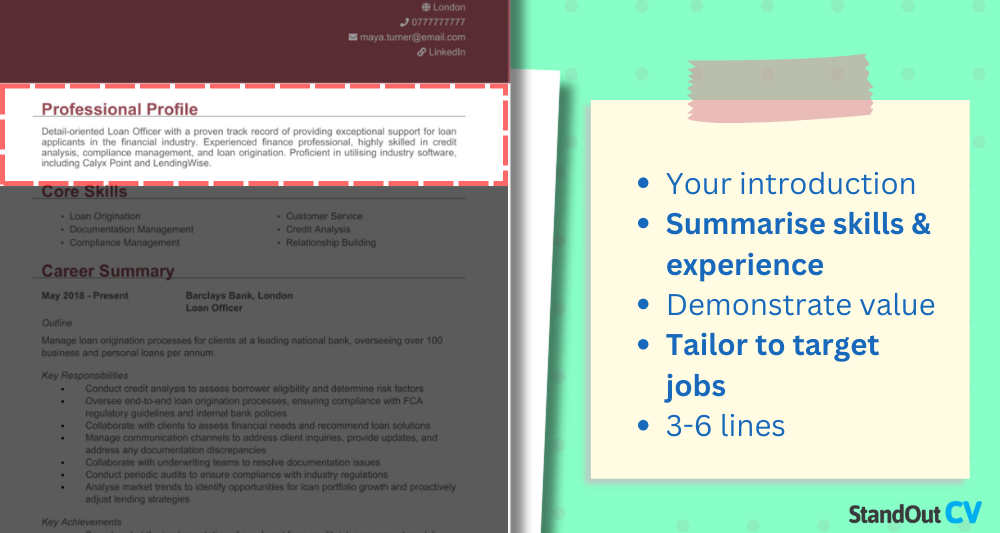
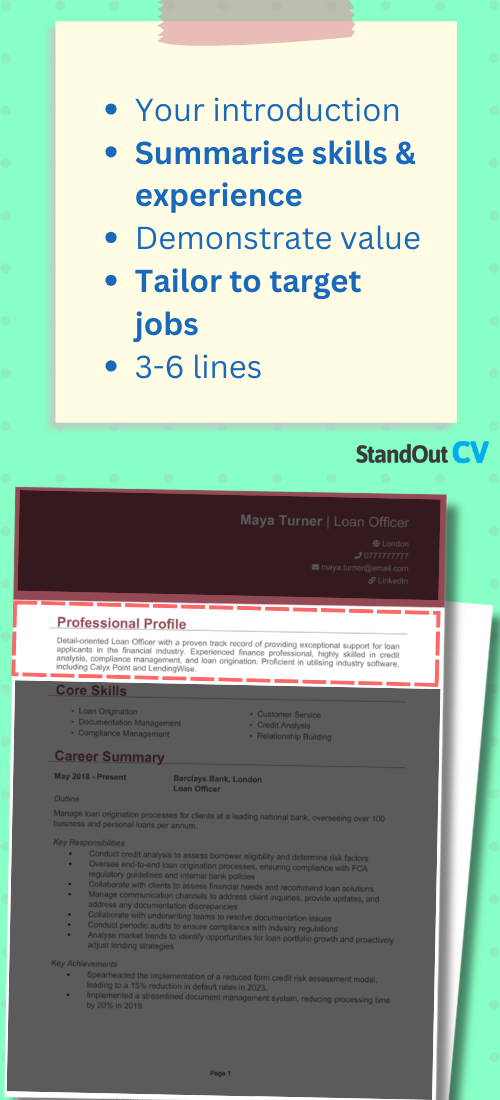
You’ve got years of hands-on experience. This section is where you turn that from ‘I did everything’ into ‘I know exactly how to add value. Your CV profile introduces you as a confident professional with entrepreneurial experience. Even if you’re stepping away from self-employment, this is your chance to show how your background has made you adaptable, commercially aware, and equipped to contribute to any team.
Business Owner CV profile examples
Profile 1
Strategic and results-driven Business Owner with over eight years of experience launching and managing a successful retail and e-commerce operation. Skilled in business planning, marketing strategy, and financial oversight. Adept at managing teams, building customer relationships, and driving revenue growth through innovation and customer service excellence. Passionate about entrepreneurship and long-term business development.
Profile 2
Experienced Business Owner with a background in hospitality and service-based businesses. Proven ability to oversee day-to-day operations, develop branding strategies, and maintain strong client retention. Skilled in managing budgets, leading staff, and delivering high-quality customer experiences. Brings a hands-on, adaptable approach to running successful independent ventures.
Profile 3
Entrepreneurial Business Owner with seven years of experience running a creative design studio serving SME clients. Experienced in project management, sales, and digital marketing. Strong understanding of business development, client acquisition, and managing workflow across multiple ongoing projects. Committed to delivering consistent, high-quality outcomes in competitive markets.
Details to put in your Business Owner CV profile
Here’s what to include:
- Where you’ve worked – Mention the nature of your business and its scale or market.
- Your top qualifications – Include business training, industry knowledge, or relevant certifications.
- Essential skills – Think leadership, operations, financial oversight, or client relationship management.
- Industry or service area – Let employers know the sectors you’ve worked in.
- Key outcomes – Include achievements like growth, profitability, or team leadership.
Show off the core skills recruiters look for
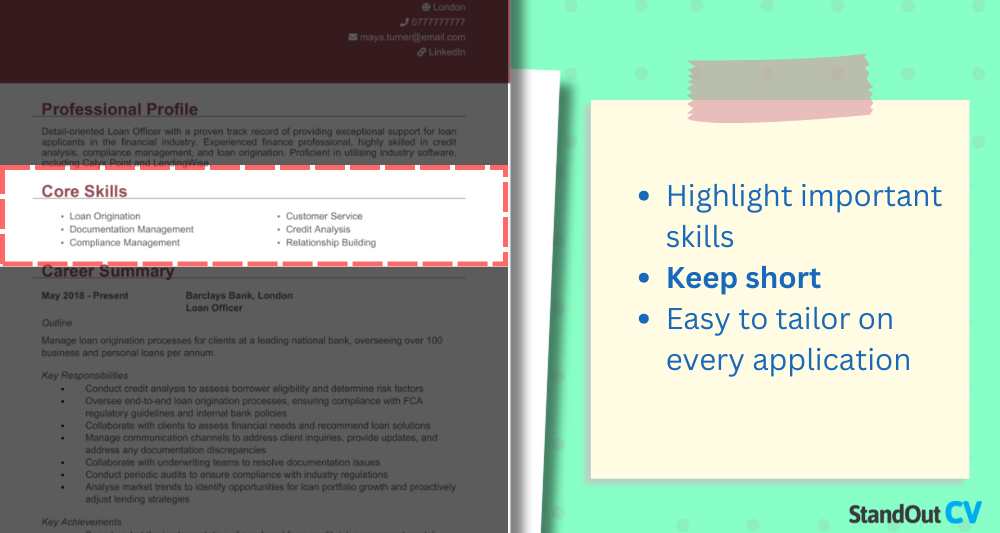

This section should capture the breadth of your expertise in a quick-glance format. As a business owner, you’ve likely gained experience in strategy, people management, sales, logistics, or marketing – highlight the areas where you’ve truly added value.
Make sure the skills for your CV align with the kind of roles you’re now targeting. If you’re moving into employment, this section is where you pivot – focusing on the transferable skills that hiring managers recognise and want.
Most important skills for a Business Owner
- Strategic Planning and Vision Setting – Defining business goals, creating growth strategies, and setting long-term direction for the company.
- Financial Management – Overseeing budgets, managing cash flow, analysing financial statements, and ensuring profitability.
- Marketing and Brand Development – Creating and executing marketing plans, managing social media, and building brand awareness.
- Sales and Customer Acquisition – Driving sales initiatives, nurturing client relationships, and expanding the customer base.
- Operations Oversight – Managing daily business activities, streamlining processes, and ensuring efficient use of resources.
- Team Recruitment and Leadership – Hiring staff, providing training, and fostering a productive and motivated team culture.
- Product or Service Development – Innovating and refining offerings based on customer feedback and market trends.
- Customer Service and Retention – Delivering excellent service, resolving issues, and encouraging repeat business and referrals.
- Legal and Regulatory Compliance – Ensuring the business operates in line with laws, licences, tax obligations, and industry standards.
- Networking and Business Development – Building relationships with partners, suppliers, and industry professionals to grow the business.
Describing your work experience
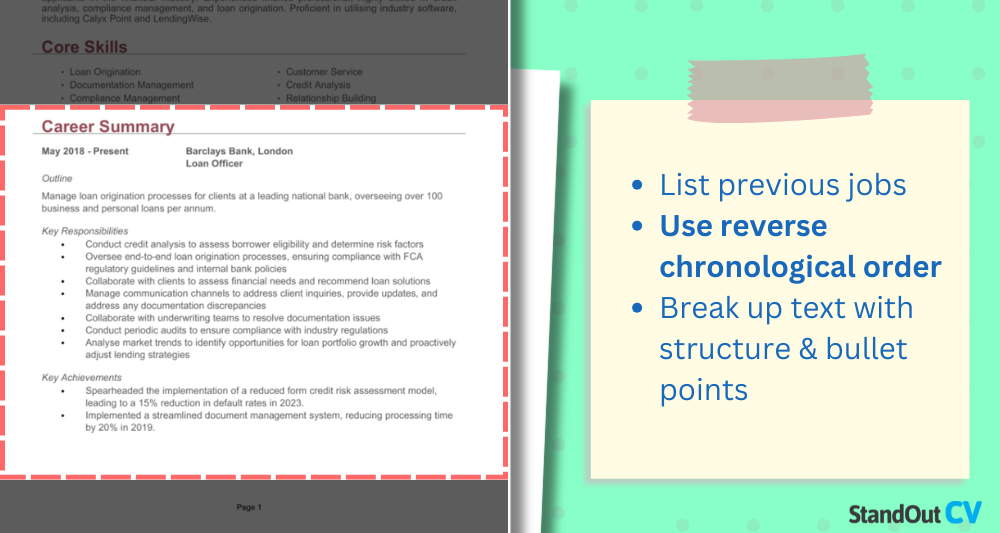
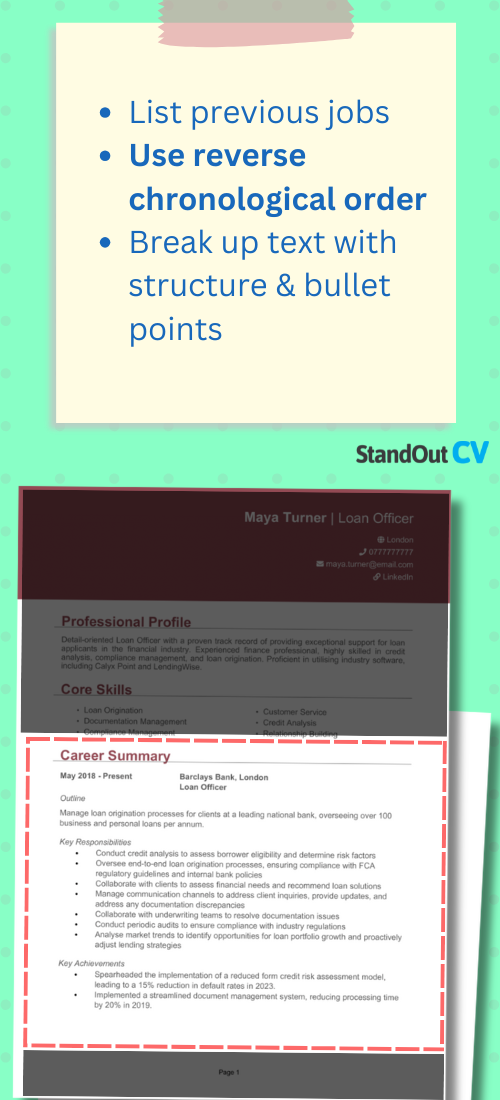
Your work experience section is where you show how you’ve applied your skills in real-world settings. You’ll need to clearly explain what you did, where you worked, and the value you brought.
List your roles in reverse chronological order, starting with the most recent. For each entry, include your job title, the company or organisation name, and the dates of employment. Then use bullet points to break down your responsibilities and key achievements – keep them concise, and focus on how you contributed to success and made a genuine, positive impact.
What’s the correct way to structure job history on your CV?
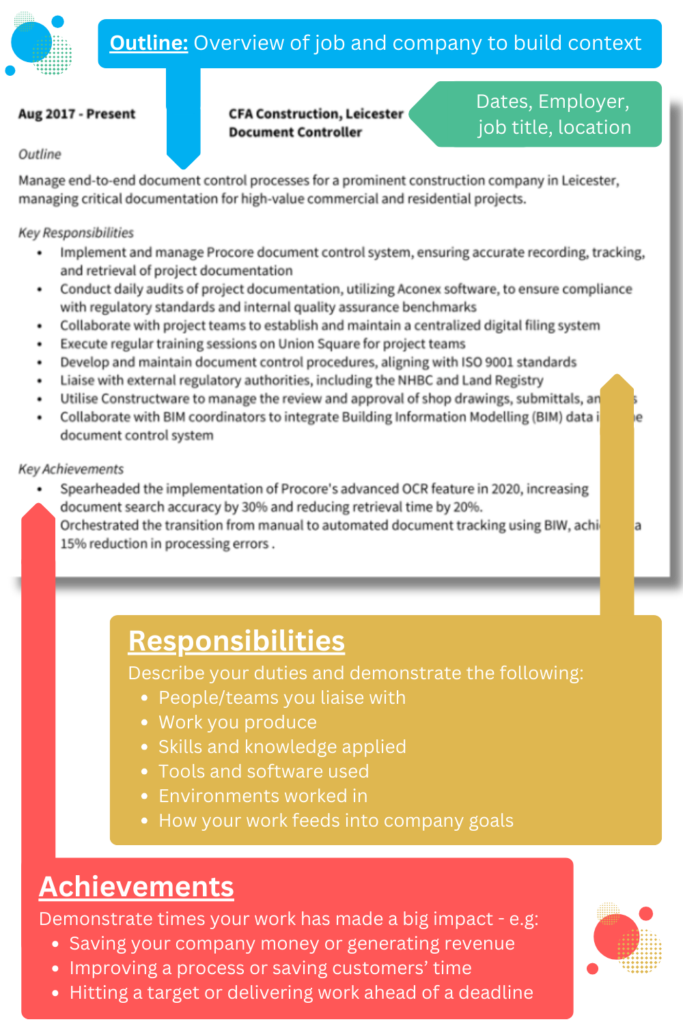
- Outline – Describe the nature of the business, your position, and its operations or client base.
- Responsibilities – Use action verbs like “led,” “launched,” “negotiated,” or “streamlined” to describe what you did day-to-day.
- Achievements – Highlight business growth, client success, team leadership, profitability, or innovations – e.g. “Grew client base by 40% in 12 months,” or “Launched three new service lines with strong ROI.”
Sample work experience for Business Owners
Business Owner | Clearview Interiors
Outline
Founded and managed a boutique interior design consultancy, overseeing business growth, client acquisition, and creative delivery for residential and commercial projects.
Responsibilities
- Managed end-to-end project delivery, from initial consultation to design execution and aftercare.
- Created business plans, pricing structures, and marketing strategies to drive growth.
- Hired and managed subcontractors, ensuring quality and adherence to deadlines.
- Maintained client relationships and secured repeat business through service excellence.
- Handled budgeting, invoicing, and supplier negotiations to maintain profitability.
Achievements
- Grew client base by 150% in two years through targeted digital campaigns and referrals.
- Achieved 95% client satisfaction rate based on post-project feedback.
- Featured in a regional interiors magazine for excellence in residential design.
Business Owner | Grindsmith Coffee Co.
Outline
Established and operated an independent coffee shop in a busy urban area, responsible for daily management, staffing, and strategic planning.
Responsibilities
- Oversaw day-to-day operations including inventory control, supplier management, and customer service.
- Recruited, trained, and managed a team of eight staff across front- and back-of-house roles.
- Developed seasonal menus and collaborated with local bakeries and producers.
- Created branding materials and managed social media to build customer engagement.
- Implemented financial tracking systems and managed payroll and tax filings.
Achievements
- Built a loyal customer base and averaged 4.8-star reviews across Google and TripAdvisor.
- Increased monthly revenue by 40% over 18 months through community marketing efforts.
- Hosted events and partnered with local artists to enhance customer experience.
Business Owner | Digital Stack Studio
Outline
Founded a freelance digital design and development agency, delivering web and branding solutions for small businesses and startups.
Responsibilities
- Designed and developed custom websites using WordPress, Shopify, and HTML/CSS.
- Managed client onboarding, project scoping, and milestone delivery.
- Produced digital assets, brand guidelines, and UX wireframes.
- Handled invoicing, contracts, and project budgets independently.
- Built and maintained long-term relationships with recurring clients.
Achievements
- Delivered over 60 web projects with 100% on-time completion.
- Grew business through referrals and online visibility, reaching six-figure annual turnover.
- Recognised by local business awards for outstanding service and innovation.
What should your CV’s education section include?
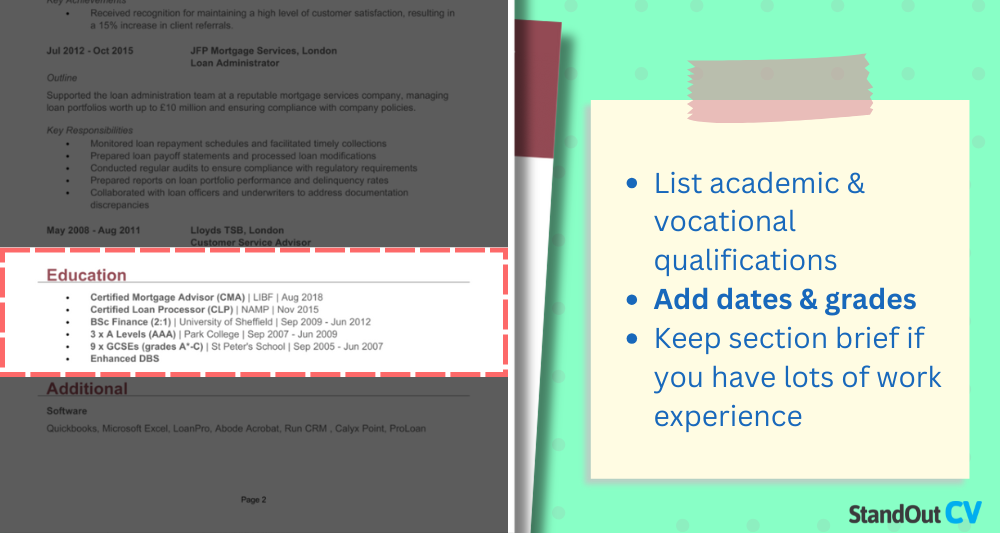

Your education section gives employers an overview of your academic background and any formal training you’ve completed. It’s a good way to show the foundations of your knowledge, as well as any additional learning you’ve pursued to develop professionally.
List your qualifications in reverse chronological order, starting with the most recent. Include the name of the qualification, the institution or training provider, and the year completed (or expected). You can also expand upon any relevant modules or specialisations – especially if they relate to the roles you’re targeting.
What qualifications do employers look for in a Business Owner?
- BSc or BA in Business, Marketing, or Management – Offers a foundation for commercial roles.
- MBA or Postgraduate Business Course – Excellent for higher-level roles or pivoting sectors.
- Leadership or Management Certificate (e.g. ILM, CMI) – Shows structured development.
- Industry-specific qualifications – Relevant to your sector (e.g. retail, health, construction).
- Project Management or Finance Training (e.g. PRINCE2, AAT) – Demonstrates practical knowledge in key business areas.


